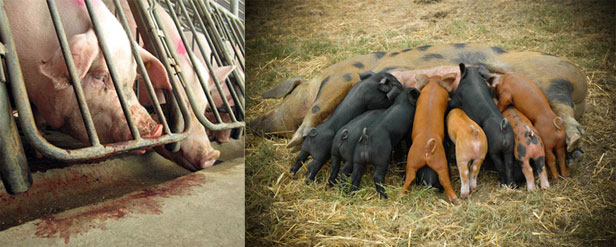 Humane touch: Which of these sows is being treated “humane”-ly? According to the National Pork Board, which permits use of the gestation crates in the lefthand photo, they both are.Photos: Humane Society (left), Clark Summit Farm (right)
Humane touch: Which of these sows is being treated “humane”-ly? According to the National Pork Board, which permits use of the gestation crates in the lefthand photo, they both are.Photos: Humane Society (left), Clark Summit Farm (right)
Americans face a dizzying array of food labels. There’s organic, all-natural, sustainable, cage-free, whole grain, and heart-healthy, to name a few.
Pop quiz: Which of these is backed by legally enforceable guidelines? Answer: Only organic. (And even that one has loopholes, such as the practice of giving chickens access to outdoor spaces but not requiring that the birds actually spend any time outside.)
The rest of these labels can be interpreted by food producers in many different ways. That’s also true for “humane,” which you may have noticed is cropping up more and more.
Whole Foods recently rolled out a humane labeling system and both Safeway and Supervalu have made animal welfare pledges. Meanwhile, even Big Meat is getting in on the act — and we do mean acting. The Humane Society has filed a class-action lawsuit against Perdue for the company’s “alleged false advertising of factory farmed chicken products as ‘humane.'”
So, how do you avoid “humane-washing”? First, understand that there are both independent and industry-produced quality assurance programs in circulation under the label of “humane.” The latter were put in place with very little public input and use experts of animal production, rather than welfare, according to a report put out by Farm Sanctuary. And each trade organization for producers, representing different farm animals, has its own set of regulations. For example:
- The National Cattlemen’s Beef Association (NCBA) has guidelines for the care of beef cattle that does not include any sort of audit. According to these guidelines, access to pasture is not required and castration without anesthesia is allowed, among other practices.
- Guidelines put out by the American Sheep Industry Association have no scoring tools for compliance or internal or external auditing. Under these guidelines, sheep farmers don’t need to provide access to grazing pasture and early weaning is acceptable.
- The National Pork Board’s Quality Assurance Plus (PQA Plus) program does not include a third-party audit. Practices allowed include confining sows to gestation crates, no access to the outdoors, and castration without anesthetics.
The closest any of the industry groups has to a third-party audit is the United Egg Producers’ program UEP Certified. Following UEP Certified, audits need to be conducted on each company’s facilities, but this may go down to 50 percent on subsequent audits. What’s more unsettling is that even within these guidelines, practices like debeaking (in which the sharp tip of a chicken’s beak is clipped by machine) and confinement in small cages is allowed. (To learn more about standard practices in factory animal farms, Sustainable Table has a helpful overview by species.)
Alternatively, various third-party auditing systems have sprung up in recent years for farms that welcome higher standards:
- Global Animal Partnership is an independent international foundation that grew out of Whole Foods’ Animal Compassion Foundation. Based on a five-step rating system, the program was designed by animal welfare advocates, animal welfare scientists, and farmers. The ratings range from Step One, “no crates, no cages and no crowding” to Step Five, “animal centered — animals spend their entire life on the same farm.”
- Animal Welfare Approved (AWA) is another independent label managed by the Animal Welfare Institute, and includes some of the highest standards in weaning, outdoor access, pasture, and physical alterations. What is unique about AWA is that the Institute doesn’t charge producers for certification, which evens out the playing field for small family farms. Unfortunately, this program is currently overseeing less than .001 percent of all U.S. animals raised for slaughter.
- Certified Humane has developed a number of standards that exceed those put out by the industry, such as banning the use of gestation crates for pregnant sows. However, the program allows feedlot confinement of beef cattle, among other practices that many would not deem humane.
- American Humane Certified is a program managed by the American Humane Society, and is similar to Certified Humane.
Confused? Me too. This is just too damn complicated. This chart for just eggs gives a glimpse into how widely industry-led and third-party standards vary:
 I egg your pardon? Welfare standards for egg-laying hens, as set by seven different certification systems.Chart: Sentient Cincinnati, modified by author
I egg your pardon? Welfare standards for egg-laying hens, as set by seven different certification systems.Chart: Sentient Cincinnati, modified by author
So what’s to be done? For now, as conscientious consumers we must take it upon ourselves to research standards and decide which practices we think can not possibly be considered humane. Or bypass those pesky labels entirely and speak directly to the farmer at your local farmers market.
Of course, one conscientious consumer does not a changed food system make. Yet something is happening. The sheer number of labels developing around the concept of animal welfare is indicative of consumer pressure. Hopefully this pressure will be able to translate into policy changes like California and Michigan’s ban on battery cages.
Until that time, I’ll just have to keep asking for sustainable-natural-organic-humane-cage-free eggs.
Some resources for consumers:
- Animal Welfare Approved’s list of what labels really mean — and what they should mean
- The Cornucopia Institute’s Organic Egg Scorecard
- A list of animal welfare labels for eggs compiled by the Humane Society
- Farm Sanctuary’s list of policy recommendations
- Find a farmers market near you
- The World Society for the Protection of Animals has food label guidelines and iPhone app



